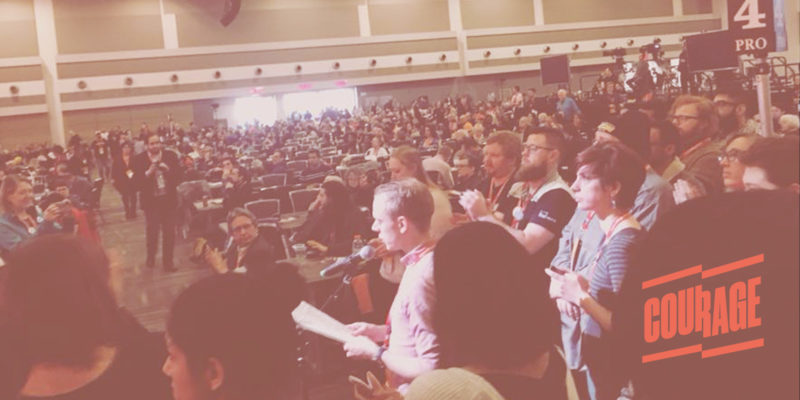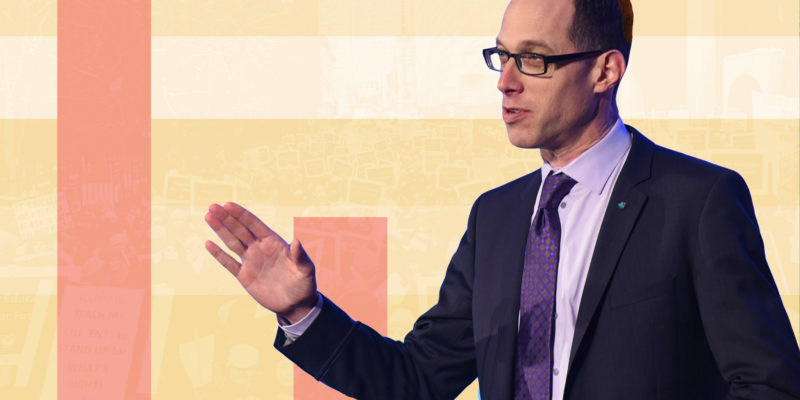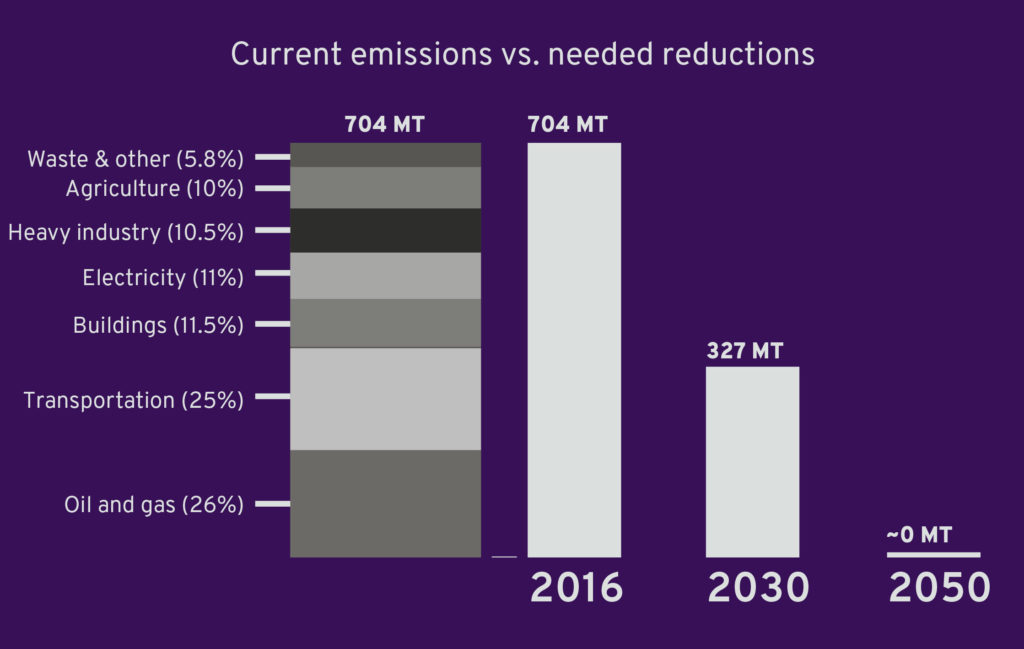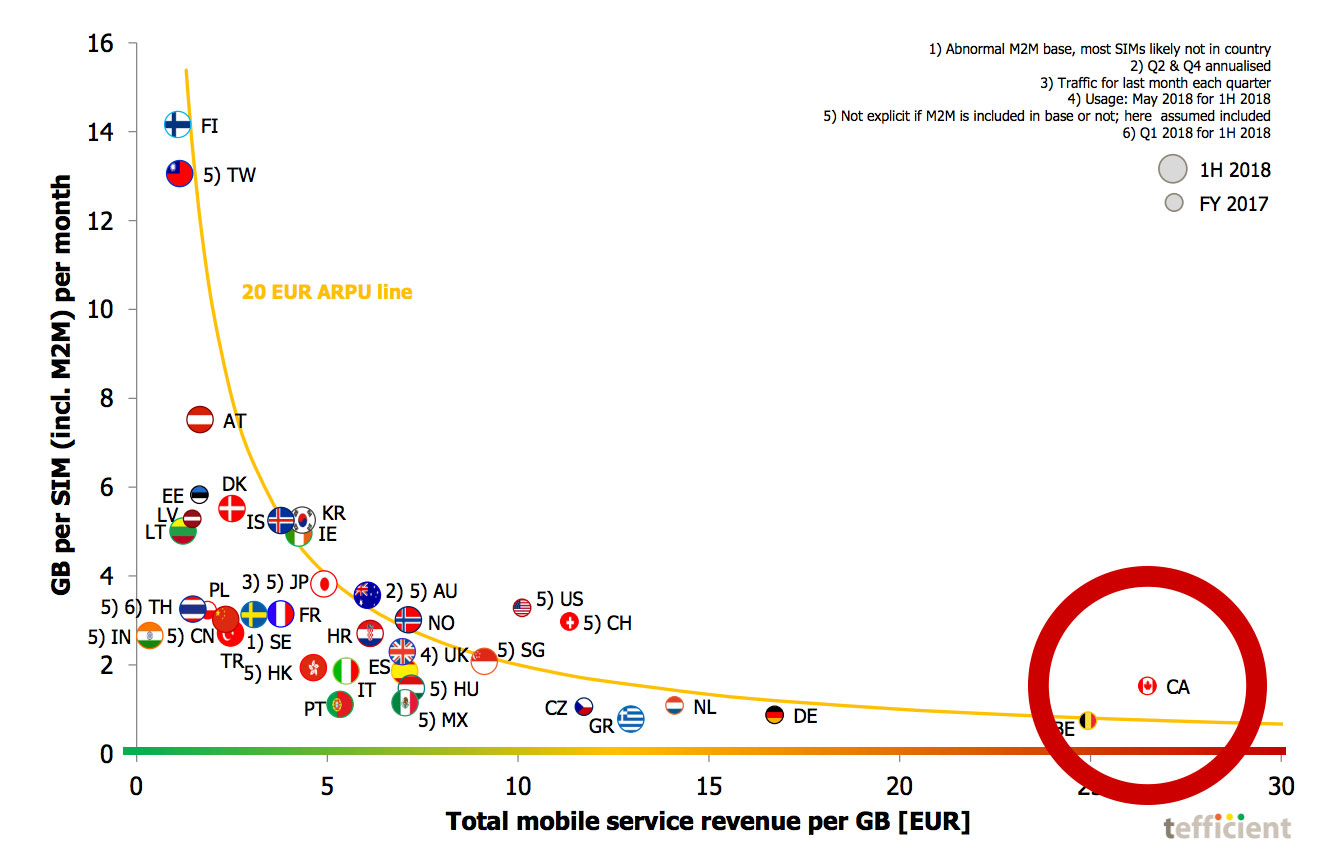Continued from Part I.
How to regulate and weaken the “Big Five”
The wave of privatization and deregulation that swept over Canada’s telecommunications industry in the 1980s and 1990s was accompanied by fulsome praise for the wonders of the market: greater competition, lower prices, better customer service, and more technological innovation. Over three decades later, the outcomes produced by these neoliberal policies are starkly different: a growing digital divide, soaring profits, and a well-entrenched telecoms oligopoly.
Collectively, Rogers, Bell, Telus, Shaw and Videotron (the “Big Five”) have cornered the market for telecommunications services. For wireless, the Big Three (Bell, Telus and Rogers) control over 90% of the market. For broadband internet, regional duopolies of two dominant providers (the local telephone company and the local cable company) hold a similar share (87%) of household connections. Overall, these lumbering, vertically-integrated giants collect 83% of all communications revenues, leaving Canadians with nowhere else to turn to.
The business practices of the Big Five bear all the hallmarks of oligopoly: stifling competition, delaying technological innovation, and keeping prices high. “Although the cable and telephone companies spend huge sums of money on advertising trying to lure each others’ customers, they rarely compete on price,” notes journalist John Cassidy. “To use the economic jargon, they act as a cozy ‘duopoly,’ keeping prices well above their costs. Many people… don’t even have two options to choose from.”
Corporate rivals in oligopolistic markets (i.e. markets dominated by a small number of very large players) tend to mirror one another’s behavior, which means they operate in much the same fashion as monopolies. Journalist Tim Wu argues, “If a monopolist did what the wireless carriers did as a group, neither the public nor government would stand for it… But when three or four firms pursue identical practices, we say that the market is ‘competitive’ and everything is fine. To state the obvious, when companies act in parallel, the consumer is in the same position as if he were dealing with just one big firm.”
Unhindered by real competition, Bell, Rogers, Telus, Shaw and Videotron are free to concentrate infrastructure spending in urban areas while neglecting rural customers, and to offer only high-priced options and bundles to the exclusion of lower-cost, basic plans. They are simply doing what corporations are supposed to do – i.e. maximizing profits for their shareholders – and they will continue to as long as their market power remains unchallenged by regulators or competitors.
The logic of oligopoly likewise dictates delaying technological innovation, in favour of wringing maximum profits from already-installed infrastructure. Not surprisingly, the incumbent cable and telephone companies are in no hurry to provide Canadians with affordable, abundant residential fibre optic connections. Indeed, Canada is recognized as a laggard internationally in the rollout of fibre-to-the-home (FTTH) connections, which offer significantly faster speeds than either cable or copper wire DSL. Fibre optic infrastructure is also key to the rollout of next generation (“5G”) wireless technology.
“The Canadian telecommunications infrastructure is still subpar and access to it is still overpriced,” writes Anthony Lacavera, former CEO and founder of Wind Mobile. “A crucial part of the infrastructure for the knowledge economy, something that needs to be the equivalent of a beautifully paved six-lane highway, is still, in a lot of parts of the country, more like a dirt road.”
The CRTC and the Competition Bureau have repeatedly recognized the market power wielded by these companies. According to the Competition Bureau, Canada’s wireless markets are characterized by “high concentration and very high barriers to entry and expansion”. As a result, Canadian telecoms are free to increase prices “without effective discipline from competitive responses by rivals.” Indeed, the Big Three exhibit a cartel-like tendency to raise prices in tandem. The Bureau’s own analyses show, in Dwayne Winseck’s words, that “oligopolistic behaviour by the big three national carriers—Bell, Rogers and Telus—is hobbling the availability of high quality, affordable mobile wireless services, especially in areas where there is no strong independent rival”.
The situation for broadband internet access is much the same. Competition among ISPs has declined massively since the 1990s, with the “incumbent carriers continuing to dominate the retail Internet access services market” and engaging in “limited rivalrous behaviour” between them with respect to fibre-based broadband networks – as the CRTC acknowledged in 2015. The Competition Bureau has likewise expressed concerns about market concentration in broadband internet services and announced its intention to investigate the sector.
Yet the response of the government and regulators to this state of affairs has been utterly inadequate: weak-kneed rulings, ministerial pleas to lower prices, and inquiries and hearings that lead nowhere. The Big Three have made a mockery of the CRTC with their pathetic response to its most recent call for low-priced cell phone plans.
The Conservatives tried to introduce a modicum of competition into the wireless market and to limit the most egregious abuses of the Big Three. But the challenge represented by Wind Mobile, Public Mobile and Mobilicity failed miserably in the face of stern opposition from the incumbents. And the incumbents are strongly resisting CRTC moves to open up fibre optic networks to rival ISPs, threatening a capital strike if regulations are not sufficiently industry-friendly.
For publicly-owned alternatives to take flight and challenge the dominant telecoms oligopoly, concerted regulatory action is necessary. Regulatory priorities should include consumer protection measures like abolishing data caps, the break-up of vertical integration between telecoms and media corporations, and the establishment of a wholesale access regime for telecommunications infrastructure that will allow public alternatives to survive and thrive. Above all, weakening the power of the telecoms oligopoly requires putting an end to the revolving door of industry insiders at the CRTC and installing commissioners with the necessary independence to face down the telecommunications industry and their army of lawyers and lobbyists.
Data caps are a particularly big source of headaches for mobile phone users. One in five (21%) Canadians continue to suffer “bill shock” due to unexpectedly high charges for data overages and roaming fees. This is a problem the “Wireless Code” – adopted by the CRTC in 2013 – was supposed to fix. A 2016 CRTC survey found that 46 per cent of Canadians had exceeded their data cap in the previous year, and were forced to pay overage fees as a result. Over one-third (36%) of these incidents resulted in monthly bills of more than $100 for customers.
The CRTC has the power to bring down prices immediately; it has simply neglected to use it until now. To protect the interests of consumers, the CRTC could abolish data caps for broadband internet and mandate unlimited data plans at affordable rates for wireless service. Other measures to protect internet users could include abolishing the anti-competitive practice of bundling and mandating simplified and standardized service contracts to encourage more transparency and greater price competition.
To preserve a free and open internet, breaking up Canada’s vertically-integrated media conglomerates must be another regulatory priority. Canada’s media landscape is exceptional for the strong vertical integration among its main corporate actors, which means that the companies that connect us to the internet are also those that produce and broadcast the content that we access.
Leveraging their control over the pipes of the internet (cables, cell towers, telephone lines) to favour their media interests is thus an irresistible temptation for these corporate behemoths. Vertically-integrated corporations also use discriminatory licensing of media content (TV shows, music, movies, etc.) and bundling to oblige internet users to subscribe to a host of other services they own.
The Big Five’s repeated attempts to weaken or violate net neutrality principles – zero rating, data throttling, website blocking – stem from efforts to protect, promote and favour content produced or distributed by their extensive media holdings. “When you allow those who control the medium to control the messages as well,” Dwayne Winseck argues, “predatory behaviour and choke points on the free flow of information will arise as sure as night follows day.”
The telecoms giants have no scruples about pressuring the media outlets they own to prevent their wireless and ISP empires from being cast in a bad light. Editorial meddling at Bell-owned outlets – in the form of stage-managed interviews, pre-arranged talking points and blackouts on coverage of unfavourable regulatory rulings – represents the “tip of the iceberg” according to journalists who spoke to Winseck on condition of anonymity. Winseck writes:
Ultimately, given Bell’s dominance across the mediascape in Canada, we have a media problem of major significance. The regulatory green light to vertically-integrated media giants was a bad idea to begin with and this is one reason why. The room for conflicts of interest is just too great and the hubris and will-to-power of those at the top seemingly impossible to keep on a short leash.
… In the end, this is not just a Bell problem or even just a media and journalism problem but a democracy problem. Canada’s largest telecoms and media giant appears to be using its media outlets to advance its own corporate interests, to meddle in government policy, and to shape the overall communications environment in which more and more of lives unfold.
Breaking up Bell and the other vertically-integrated media conglomerates does not require any new regulations. Section 36 and other relevant articles of the Telecommunications Act could be used to draw a line between content and carriage, and simply need vigorous enforcement by a truly independent regulator. Imposing strict separation between organizations that produce content, and organizations internet infrastructure through which it reaches audiences is essential to safeguard net neutrality and to free journalism and culture from the shackles of the Big Five.
Opening up space for public alternatives to expand must be another key regulatory priority. The experience of Wind Mobile should serve as a cautionary tale. One of the major obstacles to the wireless company’s attempt to break into the Canadian market was the refusal of the Big Three to sell wholesale access to their cell towers at reasonable rates, which forced the young company to spend inordinate amounts of money on building up a parallel network of its own.
The incumbents claim that this sort of “facilities-based competition” is good, since it encourages investment in infrastructure. In reality, it encourages the wasteful duplication of towers in densely-populated urban areas while doing nothing to address the neglect of rural and remote areas. (This explains the paradox of Canada having some of the highest levels of wireless investment coupled with some of the shabbiest coverage.) It represents a nearly insuperable barrier to entry that effectively shields the Big Three from competition on the basis of service and price. It also hinders innovation and the deployment of next generation networks, as former Wind Mobile CEO Anthony Lacavera notes, “When an oligopoly controls an industry – and in Bell, Telus, and Rogers, we have an oligopoly – there’s little pressure to innovate. Why bother, when building better networks costs a fortune and reduces shareholders’ dividends? What’s the hurry, when customers have nowhere else to go?”3
By mandating “structural separation” between infrastructure services and retail services in broadband, the CRTC could disable many of the mechanisms by which the Big Five have shielded themselves from competition.
The response of European countries like the UK to this dilemma has been to draw strict regulatory lines between wholesale markets and retail markets for broadband connectivity. This has meant companies can no longer wield their control of internet infrastructure – cellphone towers, fibre optic cables and telephone lines – to hobble competitors in retail markets for broadband internet and mobile phone service. The result has been significantly lower prices and more advanced networks. By mandating “structural separation” between infrastructure services and retail services in broadband, the CRTC could disable many of the mechanisms by which the Big Five have shielded themselves from competition.
* * *
The case for social ownership of all telecommunications infrastructure
Publicly-owned alternatives and the aggressive use of regulatory power will help reduce prices and improve service, and there might be a temptation to stop there. But regulation can only limit the worst abuses of the telecoms giants; it cannot eliminate the inherent tendencies towards oligopoly of telecommunications. Even in the UK, where prices are significantly lower than in Canada, cell phone customers still suffer from shoddy customer service, deceptive marketing and poor coverage, especially in rural areas. There are compelling reasons to continue to the next step: to institute social ownership of the telecommunications infrastructure and run the whole network as a publicly-owned, democratically managed, unified network.
The most compelling reason is resources. Without the surplus generated by the most profitable parts of the network (currently in the hands of the Big Five), It is difficult to imagine how a socialist administration could make the investments necessary to achieve:
-
- High speed internet in remote areas
-
- Free or extremely low-cost options for poor and working-class Canadians
-
-
- Upgraded networks connecting every building, home and device at gigabit speeds
- A flourishing of popular, democratic culture through publicly-funded arts, culture and public-interest journalism
The profits of the more densely connected urban areas are essential to realize the vision of a telecommunications network run as a universally accessible, affordable public utility. Canada’s big investment in closing the digital divide in 2018 was to invest “up to” $100 million to expand the reach of existing telecommunications provides in small towns and rural areas. Meanwhile, the CBC annually receives about $1 billion in government funding. By comparison, Canada’s “big five” telecommunications providers raked in $7.49 billion in profits in 2017. The CRTC’s 2018 investment amounts to at most 1.3% of those annual profits.
From a technical standpoint, a unified network holds out the prospect of tremendous advances in efficiency over our balkanized system. Currently, due to the paucity of interconnection points between rival corporate infrastructures, it’s normal for an email sent between two computers on the same block to route through different cities or even across borders. This is massively inefficient and has the added consequence of exposing Canadians to surveillance by US spy agencies, as Andrew Clement has demonstrated.
The divvying up and auctioning off of wireless spectrum between competing providers impedes the deployment of more efficient techniques like spectrum sharing and carrier aggregation, which can greatly improve network broadband speeds. One study found that, even in one of the busiest urban areas of the country, swathes of spectrum sit unused. These “dramatic inefficiencies in overall spectrum allocation” due to the segmentation of spectrum among different carriers, as well as carriers’ use of outdated technologies. The report called for spectrum sharing and the mothballing of this “woefully inefficient allocation method for the supposedly scarce resource of spectrum.” Collectively managing wireless spectrum as common resource would remove the artificial bottlenecks of the current system, end unnecessary replication of infrastructure, and thus lower costs for everyone.
Building a unified, nation-wide fibre optic internet backbone – high-capacity lines that carry data between networks – would require taking over the Big Five’s existing assets and making massive investments to extend service to neglected communities. This federal-level entity could resell carrying capacity at cost to municipal and provincial public providers and local cooperatives.
The success of such a publicly-owned backbone would depend on preventing the existing ISPs from rerouting their data around it through their own networks. This is exactly what happened to Alberta’s SuperNet, an internet backbone project launched in 2000 that was supposed to connect all of the province’s rural communities with high-speed connections. But as communications scholar Mike Zladjo notes, the hostility of Telus and the reticence of the Alberta government to get involved in retail services competing with private sector hobbled the project:
“It was imagined that private ISPs would connect to the network and compete with each other over the last mile for residential and business customers (see below), but in much of rural Alberta this never happened. Local incumbent TELUS preferred to use its own network, even choosing to (over)build additional facilities in places where it would have been cheaper to use SuperNet.”
By 2012, only 260 of the 429 communities initially targeted by SuperNet had broadband access. The initiative was widely recognized as a costly boondoggle for the province. Telecoms expert Robin Winsor stated in 2014 that “although many good things have come from the build of the SuperNet, its capacity has been vastly under-realized and under-utilized.”
Uruguay is a remarkable example of what a nationalized telecoms company can do in this regard. Its state-owned telecommunications provider, ANTEL, holds a monopoly on land lines and data services. It has two multinational competitors in the mobile phone space, but remains the most popular mobile provider as well. Under the left governments of the Frente Amplio, ANTEL has directed the profits from its thriving business to invest in infrastructure.
Rather than concentrating exclusively on profitable, densely-populated areas, the state-owned company has installed fiber to the home (FTTH) in 70% of the country, and committed in 2017 to establish fiber optic connections to 100% of homes in the country by 2022. Canada, by contrast, is widely recognized as a laggard when it comes to fibre deployment. Fibre-to-the-home (FTTH) connections make up only a little over 10% of total broadband connections in Canada, which ranks a dismal 25th among OECD countries. Uruguay, if compared to the OECD countries, ranks 3rd.
ANTEL also runs several TV and radio stations, providing journalism and a variety of cultural programming. The public telecommunications provider is progressive in other ways: bucking regional trends, women represent 50% of the company’s workforce, and it has been led by two women CEOs in recent years.
Next generation technologies like 5G are expected to rely on a massive investments in fibre optic infrastructure and greater sharing of the available spectrum. Indeed, the scale of investment is so huge, in both towers, spectrum and fibre, that even the Trump administration has considered that building a nationalized network may be necessary, rather than rely on a patchwork quilt of private sector ISPs and wireless providers.
The right never tires of telling us about all the ills that would befall us, if ever we were foolish enough to take telecommunication back into public hands. “GovtTel” would mean bureaucratic bloat and shoddy customer service, underinvestment and lack of innovation, loss of privacy and media manipulation, we are warned. As we have seen, there is no shortage of examples of public enterprises around the world to counter such arguments. But perhaps the most powerful answer comes from the simple fact that the current, privately-owned telecommunications system that the Big Five preside over embodies the worst case scenario that the right claims a publicly-run system would entail.
The question, then, is less “Why nationalize?” than “Why not nationalize?” Why should we let the Big Five keep the most valuable parts of our telecommunications network? Most of the infrastructure was once in public hands, after all. Telus was the product of the sell off of BCTel and Alberta’s AGT, and Bell’s Maritime holdings were once publicly-owned telcos too. Bell itself was created by an Act of parliament in 1880 and built its empire through a government-granted monopoly on Canadian long-distance telephone service that lasted nearly a century. Vidéotron was the creation of huge investments of public money (the Caisse du Dépot et placements du Québec and Investissement Québec, principally) and the cable companies were allowed to virtually print money for years due to the indulgent regulations of the CRTC. The Big Three dominate wireless largely thanks to the federal government’s giveaway of prime spectrum (frequency bands known as “beachfront property” in the industry) in the 1990s.
Concerns about excessive state control or undemocratic consequences of telecommunications nationalization are not unfounded. We can learn much from the UK, where the rise of Jeremy Corbyn and an avowedly socialist current in the Labour Party have prompted important debates over nationalization, or perhaps more accurately, socialization. The Corbyn movement is acutely aware of the shortcoming of the nationalized enterprises of post-1945 era, with their top-down, bureaucratic management structures. For this reason, the movement is exploring ideas of how to create public enterprises that are more decentralized and democratically-run, through a mix of workers’ self-management, community control, participatory planning and cooperative ownership.
* * *
From cables to what’s in them: Data, platforms and the public interest
Establishing control of the wires, cables and routers is one thing. But what about the information that flows through them?
The internet was founded on open standards, and for its first years, defied centralized control. Today, internet use is dominated by platforms: Facebook, Google and a few other corporate websites dominate total time spent online. These platforms have and exercise profound control over what is discussed and viewed by those who go online.
The Google/Facebook duopoly are also collecting vast troves of data, which is the real source of their power and profitability.
By using their control over internet users’ attention combined with vast volumes of personal information, the duopoly has used data to dominate the advertising industry. The digital advertising market grew to a value of $88 billion globally in 2017. (The market is around $3 billion in Canada, and is expected to grow rapidly.) Over 90% of that growth was captured by the duopoly.
The takeover of advertising profits by the duopoly is a major extraction of revenues that were used to fund journalism in the past by companies that produce almost no original content. Instead they pocket the profits. The devastating social, political and economic impact of this drain has only begun to be documented.
The importance of data goes well beyond the advertising business.
Data is driving many of the businesses of the future. Innovations in health, urban planning, design, and market research are all increasingly based on access to – and analysis of – large volumes of data. Development of most forms of Artificial Intelligence relies on access to data as well. The emergence of new markets and trends, from patterns of urban movement to emerging markets, can be tracked with precision – with the timely intelligence sold to the highest bidder.
The concentration of control over data about internet users in the duopoly has created a machine that can manipulate behaviour on a societal scale, amplifying patterns of activity related to everything from voter turnout to highway traffic to racism with the tweak of an algorithm,
Journalist Zeynep Tufekci has described the tendency of algorithms to show users on platforms like Youtube more and more intense versions of content they have viewed – perhaps as a side effect of analyzing which recommended content is likely to keep users clicking on the site. For example, Tufekci noticed that right-wing videos would lead to progressively hateful and racist videos. In a talk by the same title, she remarked: “we’re building a dystopia just to make people click on ads.” “This isn’t a community,” she wrote elsewhere. “This is a regime of one-sided, highly profitable surveillance, carried out on a scale that has made Facebook one of the largest companies in the world by market capitalization.”
Whether it’s control over the $88 billion digital ad market, control over the means of innovation, or the ability to manipulate the behaviour of entire societies, we can’t afford to leave control in the hands of the duopoly. As Silicon Valley entrepreneur and author John Battelle put it in recent testimony to the US Senate, maintaining a status quo “where most of the valuable information is controlled by an increasingly small oligarchy of massive corporations – is to imagine a sterile landscape hostile to new ideas and mass flourishing.”
What, then, is to be done? The infrastructure, cash, technical knowledge and institutional power of publicly owned telecommunications network would give our societies tremendous leverage to build alternatives to the dystopic data duopoly.
But we have to start imagining a better future for data and platforms now. Much more discussion is needed, but a few suggestions to kick things off follow.
1. Invest in alternatives
The internet was built on open standards like HTTP, email, USENET and FTP, where common data protocols allowed many people to host information in a decentralized way. However, as private money poured into platforms like Facebook and Google, open standards failed to keep pace with the speed and slick user experience of the private platforms and the flood of spam and phishing that threatened to overwhelm open systems.
By pouring millions into creating a better user experience, the duopoly has effectively enclosed the information commons of the web.
There is, however, nothing that preordains the dominance of private platforms over open standards. There are many efforts to develop decentralized social media protocols, including projects like Diaspora, Scuttlebutt, and Solid (the latter led by the inventor of the web, Tim Berners-Lee). If these efforts benefitted from an influx of tens or hundreds of millions in public investment (spare change by Canadian telco standards), or promotion by public internet providers, they could become far more robust and widely used.
Open source projects like Linux show that sophisticated software infrastructure can be managed as a commons, with a whole business ecosystem generating value for the commons and providing services. With significant investment, it is possible to displace the duopoly with an open system owned by all.
2. Regulate existing actors
Google and Facebook provide users access to some of their own data, and some control over who else can see it – though “don’t let the duopoly look at my data” is never an option. The real aim should be to give both individuals and communities fine-grained control over both who is excluded, but also who gets the benefit of easy-to-access data.
For example, a well-regulated Facebook would provide a control panel that allows one to disallow them from accessing my data when they’re conducting analysis for any military-related applications, but at the same time allow access to information about one’s movements to inform improvements to public transportation and reduce climate emissions in their city.
Neighbourhoods, cities and regions should also be able to collectively allow or disallow use of data that they collectively agree is in the public interest.
User-friendly tools should also be available to remove unwanted data from the system, or to charge for access to certain kinds of data when it is being used to create for-profit applications. Currently the duopoly profits from that data, even though it’s the user who generates it. What if users or regions had collective control over some or all of the profits generated by serving ads in their feeds – or the ability to eliminate them and finance their infrastructure in other ways?
The duopoly won’t submit to these kinds of empowering encroachments on their control without a fight. However, public ownership and federated cooperative control of telecommunications could bring a lot of institutional power to induce productive negotiations and build democratic alternatives.
3. Create the data commons
The history of social democracy shows us that regulations are usually granted by capital on a temporary basis; once they amass enough power, elites tend to roll back regulations that limit them or create a new system that renders those limitations obsolete.
Evgeny Morozov writes that that a “better agenda for left-leaning populists would be to insist that data is an essential, infrastructural good that should belong to all of us; it should not be claimed, owned, or managed by corporations.”
He continues: “Enterprises should, of course, be allowed to build their services around it but only once they pay their dues. The ownership of this data – and the advanced AI built on it – should always remain with the public. This way, citizens and popular institutions can ensure that companies do not hold us hostage, imposing fees for using services that we ourselves have helped to produce. Instead of us paying Amazon a fee to use its AI capabilities – built with our data – Amazon should be required to pay that fee to us.”
There are many conundrums to solve when it comes to the massive power that centralized data stores create. Would we entrust it to the government and open the door to the potential for totalitarian surveillance? Should we decentralize access to data and then federate for the common good and risk regional variations?
There is at least one very interesting precedent. Estonia has instituted a digital identity card that is used in voting, health care, public transportation and banking. The country’s system gives each user a high degree of control over which institutions have access to different kinds of data collected about them. The result has been a proliferation of applications built on this data layer.
It’s hard to imagine a similar system working in countries where trust in the government is – often justifiably – much lower. However, the Estonian precedent is helpful in imagining ways to create a data commons outside of corporate profiteering.
The de facto control that has been granted to the duopoly over vast amounts of user data sets the bar low: almost any increase in transparency and user control would be an improvement. There are no easy answers, but the basics are there: we can do better than the duopoly, and we need to start thinking about how to accomplish that now.
Market Governance, Centralized Control, or Democratic Federalism?
Above, we have outlined four steps to a democratic telecommunications system that serves the public good. To recap:
- Create Alternatives: Establish a national publicly-owned provider from the bottom up
- Break the Power of the Monopolies: Use regulatory powers to increase quality of services, end monopolistic practices and reduce prices
- Take Back Control: Nationalize the telcos and implement cooperative federated control in the public interest
- Seize the Future: Start building the data commons and take back the platform layer
There will be opportunities aplenty for half measures. Breaking up monopolies, or introducing a new for-profit competitor to moderately reduce prices, may become enticing short term compromises that could rob a visionary movement of precious momentum.
Bigger reforms could be similarly fraught: if we create a national telecommunications monopoly run in a top-down fashion by political appointees, much of the potential of public ownership will be squandered. The CBC and Canada Post are our Crown Corporation cautionary tales here: yes, they provide better service than any private alternative, but they fall well short of their potential to serve the public good.
To create truly democratic institutions that serve a vast and diverse geographical area requires a high degree of local control over decision making as well as strong powers of redistribution and coordination. To create that, we’ll need grassroots initiatives, federal-level policy vision and everything in between, working in coordination.
The difficulties won’t end there. The challenge of any democratic institution is to create conditions to be continually renewed by grassroots engagement – not just input, but powerful challenges that shape and renew the institution without undermining its commitment to the public good and openness to offering the same opportunities to future grassroots initiatives.
This requires rare and endangered species to take their place in a new political ecology:
- the bureaucrat who is as technically knowledgeable as they are politically supple;
- the administrator who is as boldly decisive as their listening is acute;
- the local grassroots organizer whose vision for the good of their community is aligned with a regional and continental vision.
In this sense, fighting for a democratic, public interest telecommunications infrastructure and data commons embodies many of the same challenges that we are likely to face in constructing a socialist society and economy that is truly democratic. No accident, that.
Main writer/researcher: Nikolas Barry-Shaw (with contributions from several Courage members)















